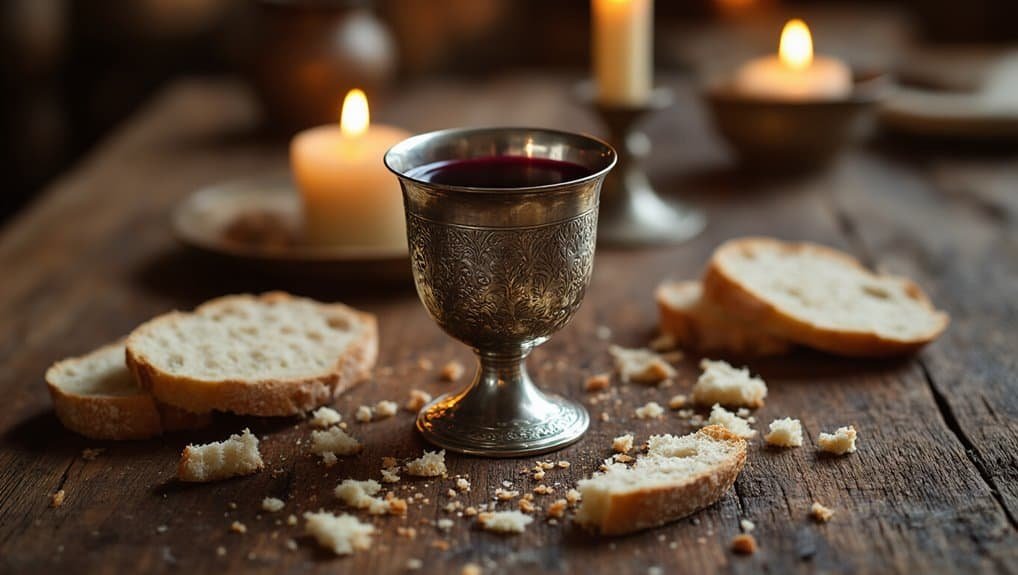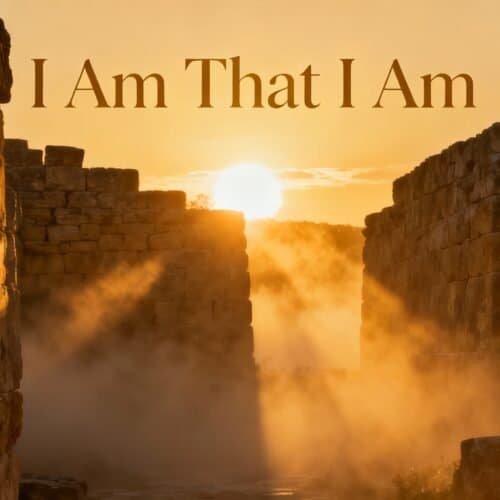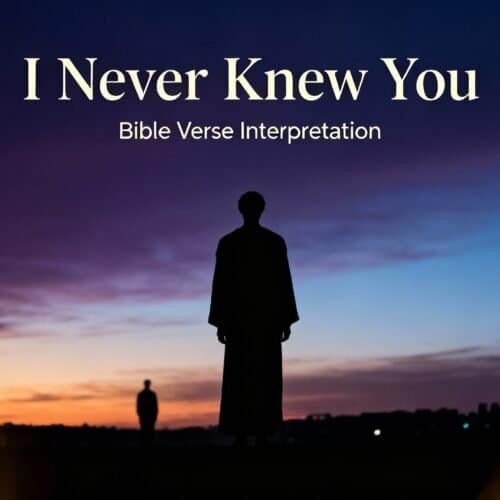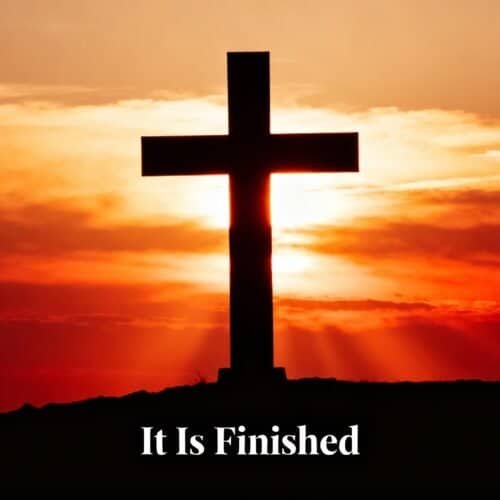
07 Nov What Key Bible Verses on Last Supper?
You’ll find the Last Supper’s essential verses across the Synoptic Gospels and John’s account. Matthew 26:26-28, Mark 14:22-24, and Luke 22:19-20 preserve Christ’s words instituting the Eucharist—”This is my body” and “This cup is the new covenant.” John 13:1-17 presents the footwashing narrative, while John 13:34-35 introduces the new commandment to love. Paul’s 1 Corinthians 11:23-26 adds Christ’s memorial command. These nine passages transform a Passover meal into Christianity’s foundational covenant moment.
Table of Contents
Key Takeaways
- Matthew 26:26-28, Mark 14:22-24, and Luke 22:19-20 record Jesus instituting the Lord’s Supper with bread and wine.
- John 13:34-35 contains Jesus’ new commandment to “love one another” as the distinguishing mark of discipleship.
- 1 Corinthians 11:23-26 preserves Paul’s account including Christ’s command “do this in remembrance of me.”
- John 13:1-17 narrates Jesus washing the disciples’ feet, demonstrating servant leadership before the meal.
- Matthew 26:21-25 and parallel passages reveal Jesus predicting Judas’s betrayal during the Last Supper.
Jesus Washes the Disciples’ Feet (John 13:1-17)
When Jesus stooped to wash His disciples’ feet during the Passover meal, He performed an act that would’ve shocked any first-century Jewish observer. In Greco-Roman society, foot washing was reserved for the lowest servants, yet here’s the Rabbi assuming this degrading position.
The Rabbi assumes the degrading position reserved for the lowest servants, shocking every first-century observer.
The basin symbolism extends beyond mere cleanliness—it represents spiritual purification and the washing away of worldly pride.
Peter’s initial refusal and subsequent overcorrection reveal the disciples’ struggle to comprehend this radical demonstration of servant leadership. You’re witnessing Jesus redefine authority through ritual humility, transforming a menial task into sacred instruction.
The imperative in verse 14, “you also ought to wash one another’s feet,” isn’t merely about replicating the physical act but embodying humble obedience in community relationships.
This pericope establishes a new paradigm where greatness’s measured by service, not status. Christ’s actions prefigure His ultimate self-emptying on the cross, teaching that divine love manifests through deliberate self-abasement.
The Bread as Christ’s Body (Matthew 26:26, Mark 14:22, Luke 22:19)
When you examine the synoptic accounts of the Last Supper, you’ll notice that Christ’s act of breaking bread becomes the pivotal moment of institutional transformation. The parallel passages in Matthew, Mark, and Luke preserve Jesus’ words with remarkable consistency: “This is my body,” establishing what scholars recognize as the verba institutionis or “words of institution” that would define Christian eucharistic practice.
These texts reflect early Christian liturgical formulas already circulating in the first-century church, as Paul’s earlier account in 1 Corinthians 11:23-24 demonstrates the tradition’s antiquity.
Breaking the Bread
Jesus took bread, blessed it, and broke it before His disciples, transforming this ordinary act into Christianity’s most profound sacramental moment. You’ll notice the Gospel writers emphasize Christ’s deliberate physical action—the Greek verb “klao” denotes forceful breaking, not gentle tearing. This breaking prefigures His body’s crucifixion, establishing symbolic sharing as the foundation of Christian worship.
When you examine first-century Jewish meal practices, bread-breaking initiated communal fellowship, binding participants in covenant relationship. Christ’s action transcends cultural custom, however. He doesn’t merely distribute bread; He fractures it, demonstrating how His broken body becomes the means of spiritual nourishment. The synoptic accounts preserve this sequence meticulously: taking, blessing, breaking, giving—each verb carrying theological weight that you’ll find echoed throughout Acts and Paul’s epistles.
Words of Institution
Speaking the words “This is my body,” Christ transforms the broken bread into Christianity’s central mystery, commanding you to understand His physical presence through sacramental reality.
You’ll find Matthew, Mark, and Luke preserve these words with remarkable consistency, establishing the foundation for Eucharistic theology that would shape centuries of Christian worship.
When you examine the Greek text, Christ’s use of “estin” (is) creates interpretive tensions that’ve divided denominations.
The Synoptics’ parallel accounts reveal liturgy origins in early Jewish-Christian communities, where you’d hear these words repeated weekly.
Luke’s addition of “given for you” connects the bread to sacrificial language, while Matthew and Mark maintain brevity.
You’re witnessing not merely symbolic gesture but theological proclamation—Christ identifying His body with the Passover’s broken bread, establishing the new covenant‘s central act.
The Cup as the New Covenant (Matthew 26:27-28, Mark 14:23-24, Luke 22:20)

The significance of covenant theology reaches its culmination when Christ lifts the cup and declares it represents his blood of the new covenant.
Christ’s declaration over the cup marks covenant theology’s supreme moment—his blood inaugurating the new covenant.
You’ll notice Matthew’s account explicitly states this blood is “poured out for many for the forgiveness of sins,” directly linking the cup symbolism to atonement. Mark’s parallel text emphasizes the sacrificial nature, while Luke uniquely positions the cup “after supper,” highlighting its distinct covenantal function.
When you examine the Greek term “diathēkē” (covenant), you’re encountering language that evokes Jeremiah 31:31‘s prophecy of God establishing a new covenant with Israel.
The redemptive covenant Christ institutes supersedes the Mosaic covenant, not through animal sacrifice but through his own blood. You can’t overlook how Jesus transforms the Passover’s third cup—traditionally the cup of redemption—into the vehicle for announcing this new covenant reality. This moment crystallizes salvation history’s pivotal transition from old to new covenant administration.
Christ’s Command to Remember (1 Corinthians 11:23-26)
Paul’s account in 1 Corinthians 11:23-26 preserves Christ’s explicit command to commemorate the meal, transforming it from a single historical event into a perpetual ordinance for the church.
You’ll notice the imperative “do this in remembrance of me” appears twice—once after the bread and again after the cup—establishing anamnesis (ritual remembrance) as central to Christian worship.
Through this repeated act, you’re not merely recalling past events but proclaiming Christ’s death until his return, making the meal both memorial and eschatological proclamation.
Do This Remembering Me
When you examine Paul’s account of the Last Supper in 1 Corinthians 11:23-26, you’re encountering the earliest written record of Jesus’s final meal with his disciples—predating even the Gospel accounts. Paul’s Greek phrase “touto poieite” (“do this”) transforms bread-breaking into a memorial meal, establishing perpetual covenant remembrance through ritual reenactment.
You’ll notice Christ’s command appears twice—once with bread, once with wine—creating deliberate parallelism that emphasizes continuity. The phrase “eis tēn emēn anamnēsin” (“in remembrance of me”) doesn’t suggest mere recollection but active participation in salvation history. Ancient Jewish memorial practices inform this language, where remembering means making past events present realities.
Through this commanded observance, you’re proclaiming Christ’s death “until he comes,” linking past sacrifice with future consummation.
Proclaim His Death
Beyond establishing memorial practice, Paul’s text reveals that participation in the Lord’s Supper constitutes proclamation itself—”katangellō” in Greek, meaning to announce or declare publicly.
When you partake of the bread and cup, you’re not merely remembering privately; you’re making a public declaration of Christ’s salvific work.
The phrase “until he comes” frames this proclamation within eschatological expectation, linking Christ’s death to his anticipated return.
You proclaim resurrection through this act—death isn’t the final word but the gateway to new life.
The Supper becomes kerygmatic, announcing the gospel’s core message each time you observe it.
You also proclaim grace, testifying that salvation comes through Christ’s sacrificial death, not human merit.
This proclamation transcends verbal testimony; the ritual itself becomes evangelistic witness to both believers and observers.
Judas Identified as the Betrayer (Matthew 26:21-25, John 13:21-30)
You can almost feel the tension mounting in the upper room as Jesus drops a devastating announcement: one of the twelve disciples will betray him. Matthew’s account reveals the group tension immediately erupting as each disciple questions, “Surely not I, Lord?” This culpability debate exposes their guilt psychology—they’re examining their own hearts for potential treachery.
The mounting tension erupts as each disciple examines their own heart for potential treachery.
The meal dynamics shift dramatically when Jesus employs the betrayer identification method of the shared dish. John’s narrative adds secretive behavior details: Jesus gives Judas the bread, and Satan enters him. You’ll notice the prophetic fulfillment unfolding as Christ orchestrates these events, knowing Judas had already negotiated his auctioned payment of thirty silver pieces.
The textual analysis shows contrasting responses: eleven disciples address Jesus as “Lord” while Judas calls him “Rabbi.” This linguistic distinction highlights Judas’s spiritual distance.
Historical context suggests such intimate meals emphasized loyalty, making the betrayal particularly heinous within Jewish hospitality customs.
Peter’s Denial Foretold (Luke 22:31-34, John 13:36-38)
Peter’s passionate declaration of loyalty immediately follows the betrayal announcement, yet Jesus reveals a sobering prophetic warning that’ll shatter the disciple’s self-confidence.
In Luke’s account, you’ll notice Jesus addresses Peter as “Simon,” his pre-discipleship name, signaling an impending faith failure. Christ’s statement that Satan has “demanded to sift you like wheat” employs agricultural imagery familiar to first-century Palestinians, depicting violent separation of grain from chaff.
Despite predicting Peter’s threefold denial, Jesus offers a restoration promise: “when you’ve turned back, strengthen your brothers.” This rescue prayer demonstrates divine foreknowledge doesn’t negate human responsibility.
John’s parallel account emphasizes the denial consequences through specific timing—”before the rooster crows”—a detail marking the Roman watch system’s third division (3:00 AM). You’re witnessing theological tension between divine sovereignty and human weakness.
Peter’s protestations reveal his misunderstanding of spiritual warfare’s nature. He can’t comprehend how quickly circumstances will expose his vulnerability when stripped of Christ’s immediate presence.
The Promise of the Holy Spirit (John 14:15-17, 25-26)
During the farewell discourse, you’ll notice Jesus introduces the Paraclete—a Greek term meaning advocate or helper—who will permanently dwell with the disciples after his departure.
Christ’s promise in John 14:15-17 links the Spirit’s arrival to obedience (“if you love me, keep my commands”), while verses 25-26 emphasize the Spirit’s pedagogical role in preserving and interpreting Jesus’ teachings.
This pneumatological shift represents a crucial transition from Christ’s physical presence to the Spirit’s ongoing ministry in the early church community.
Spirit as Helper
This Comfort Counselor functions distinctively from Christ’s physical presence.
While Jesus’s earthly ministry faced temporal limitations, you’re assured the Spirit’s perpetual indwelling. John’s Gospel emphasizes the Spirit’s teaching role—he’ll remind you of Christ’s words and guide into all truth.
This promise addresses the disciples’ immediate anxiety about Jesus’s departure while establishing the pneumatological foundation for the church’s mission. The Spirit doesn’t replace Christ but continues his work through different means.
Teaching and Remembrance
You’ll frequently encounter Jesus’s pedagogical promises in John 14:25-26, where he explicitly links the Spirit’s arrival to educational continuity.
The text presents the Paraclete as divine instructor who’ll “teach you all things and bring to your remembrance all that I’ve said.” This dual function—teaching and reminding—shapes early Christian faith formation by establishing pneumatological authority for apostolic witness.
The Spirit’s anamnetic role proves crucial for ritual practice, particularly in eucharistic celebrations where communal memory transforms bread and wine into vehicles of divine presence.
You’re observing here the foundations of sacramental theology: the Spirit doesn’t merely recall past events but actualize Christ’s presence through liturgical remembrance.
This pneumatic pedagogy ensures doctrinal transmission while maintaining experiential immediacy, bridging the historical Jesus with post-resurrection communities through divinely guaranteed instruction.
Jesus as the True Vine (John 15:1-8)
Following his institution of the Eucharist, Jesus employed the powerful metaphor of the vine to illuminate the nature of discipleship and spiritual fruitfulness. You’ll find this discourse strategically placed after the bread and wine, creating theological continuity between sacramental union and spiritual vitality.
The vine imagery wasn’t arbitrary—it drew from Israel’s self-understanding as God’s vineyard (Isaiah 5:1-7). When Jesus declared “I am the true vine,” he’s repositioning himself as authentic Israel, the source of covenant life. You’re confronted with radical dependence: branches can’t survive apart from their life source.
The text emphasizes an abiding relationship through the verb “remain” (Greek: menō), appearing eleven times in eight verses. You’ll notice fruitfulness discipleship isn’t about human effort but divine connection. The agricultural metaphor would’ve resonated with first-century Palestinians who understood viticulture’s demands. Jesus isn’t offering optional spiritual enhancement—he’s describing existential necessity for those who’d follow him beyond the upper room.
The High Priestly Prayer (John 17:1-26)
Jesus’s movement from vineyard metaphor to sacerdotal intercession marks the culmination of his upper room discourse, as he lifts his eyes heavenward and addresses the Father directly in what scholars designate his “High Priestly Prayer.”
Christ’s sacerdotal intercession transcends vineyard metaphor, culminating the upper room discourse through heavenward address scholars designate his High Priestly Prayer.
The prayer’s tripartite structure—Jesus praying for himself (vv. 1-5), his disciples (vv. 6-19), and future believers (vv. 20-26)—mirrors ancient Jewish intercessory patterns while transcending them through its christological focus.
You’ll notice Jesus’s eternal intercession begins with glorification language reminiscent of Daniel 7:13-14, establishing his divine authority before petitioning for his followers.
His plea for kingdom unity among believers (v. 21) doesn’t merely seek organizational coherence but ontological participation in the divine fellowship.
The prayer’s liturgical character suggests John’s community used it cultically, viewing Christ’s words as perpetually efficacious.
You’re encountering here not historical reportage but theological interpretation, where Jesus functions simultaneously as sacrifice and priest, fulfilling Melchizedek’s typology while inaugurating eschatological reconciliation between heaven and earth.
The New Commandment of Love (John 13:34-35)
The mandate to “love one another” emerges within John’s farewell discourse as both ethical imperative and ecclesiological foundation, positioned strategically after Judas’s departure (13:31) to address the remaining faithful community.
You’ll notice Jesus doesn’t merely reiterate existing commandments but establishes something “new” (καινὴν). This newness isn’t temporal but qualitative—love modeled after Christ’s own sacrificial example (“as I’ve loved you”).
The commandment’s placement following the footwashing narrative reinforces servant leadership as love’s practical expression. You’re witnessing Jesus transform social hierarchies through radical love that transcends conventional boundaries.
The phrase “by this all will know” (v. 35) establishes love as the church’s distinguishing mark—not doctrinal precision or ritual observance, but visible mutual affection.
This commandment functions programmatically throughout John’s Gospel, where love becomes both the means of discipleship and its ultimate goal. You’ll find this love isn’t sentimental but costly, demanding the same self-giving that leads Jesus to the cross.
Frequently Asked Questions
What Day of the Week Did the Last Supper Occur?
You’ll find the Last Supper occurred on Thursday evening, based on Gospel chronology and Passover alignment in the Jewish calendar. The Synoptic Gospels present it as a Passover meal, while John’s account suggests it preceded Passover by one day.
You’re examining texts where Mark 14:12-17 explicitly states it was “the first day of Unleavened Bread,” confirming Thursday’s significance in the passion narrative’s temporal framework and liturgical tradition.
Where Exactly in Jerusalem Was the Last Supper Held?
You’ll find the Last Supper occurred in Jerusalem’s Upper Room, traditionally identified as the Cenacle on Mount Zion.
Mark 14:15 and Luke 22:12 describe a “large upper room furnished and ready.”
This location sat within the city walls, accessed through the City Gate system.
Archaeological evidence suggests wealthy households near the southwestern hill possessed such dining spaces.
You’re looking at a second-story room, likely in the Upper City’s affluent quarter where disciples prepared the Passover meal.
How Long Did the Last Supper Meal Last?
You’ll find the Gospels don’t specify the meal duration, but scholarly analysis suggests it lasted several hours.
The ritual timing began after sunset, following Jewish custom for Passover celebrations.
You’re looking at approximately three to four hours based on textual analysis of the discourse content, prayers, and ceremonial elements described.
The historical context indicates such festive meals typically extended well into the night, combining eating with extensive teaching and fellowship.
What Other Foods Were Served Besides Bread and Wine?
You’ll find the Gospels don’t specify other foods, but historical analysis reveals typical Passover traditions included bitter herbs, charoset (fruit-nut paste), and roasted lamb.
Mediterranean dishes common to first-century Jewish meals would’ve featured olives, dates, and fish.
The synoptic accounts emphasize bread and wine‘s theological significance while omitting culinary details.
John’s Gospel doesn’t mention institution words, focusing instead on foot-washing, suggesting the evangelists prioritized symbolic over dietary elements.
Did Any Disciples Besides Judas Leave During the Meal?
You’ll find no biblical evidence that other disciples left during the meal itself. John’s Gospel clarifies the betrayal timing – Judas departed immediately after receiving the bread (John 13:30).
The servant washing occurred before this departure, with all twelve present. Peter’s denial predictions and disciples’ disputes about greatness happened while everyone remained at table.
The Gospel accounts consistently portray eleven disciples staying throughout the Passover meal until they departed together for Gethsemane.
Conclusion
You’ve explored the Last Supper‘s foundational texts that shape Christian theology and practice. These passages don’t merely record historical events; they establish the Eucharistic tradition, define discipleship through servant leadership, and articulate the new covenant‘s theological framework. When you examine John’s extended discourse alongside the Synoptic institution narratives, you’ll discover complementary perspectives on Christ’s final teachings. This textual analysis reveals how early Christian communities understood Jesus’s death as inaugurating a transformative covenant relationship.











No Comments